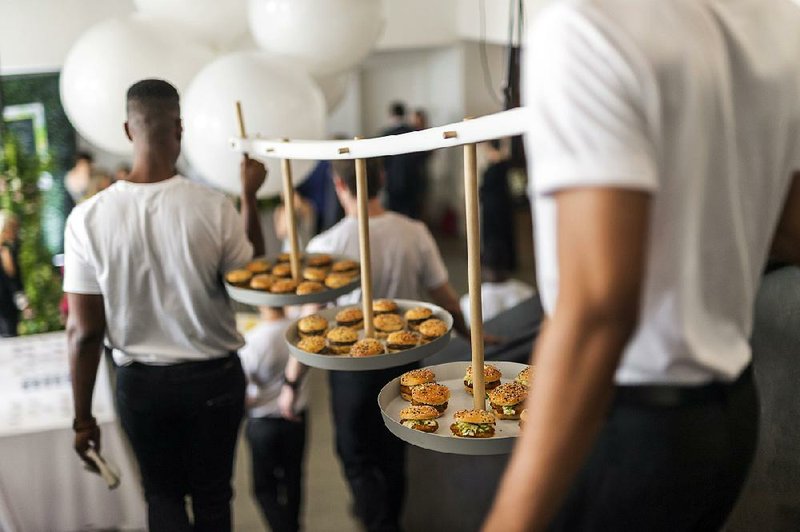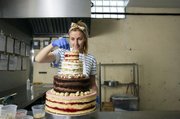All the tasting-menu options that Susan Shek and Noah Sexton have sampled for their August wedding are delicious, but they want food that makes a visual statement.
They are leaning toward caviar on a buckwheat blini that bears no resemblance to a blini; it is a squat little tower made of reconfigured blini ingredients. The caterer has also suggested the steak frites, a slender rectangle of beef encircled by a flat ribbon of fried potato that floats inches above it, anchored at the base.
These are just two of 16 image-forward hors d'oeuvres offered by Pinch Food Design, a Manhattan caterer. Other potential menu items include "tartare Jackson Pollock style" -- the sauce spattered over chunks of raw salmon or tuna -- and shards of chocolate bark dangling from the spokes of a large umbrella that a server carries at the reception, inviting guests to pluck at will.
Expectations for wedding meals have been rising for years. Couples raised on food television have a palpable disdain for the old formula of fish, chicken or beef accompanied by a vegetable and a starch. And it is not uncommon for a bride and groom to ask how and where the components of their meal were grown, raised or slaughtered.
But big-city wedding planners and designers say a new criterion is coming into play: The food has to have a distinctive, if not downright startling, look. It has to grab the eye as much as the palate, and should be displayed on something more exciting than standard banquet tableware. If there is a performance element to the presentation, as with the traveling chocolate bark, so much the better.
"The camera eats first," Shek said. She is a wedding photographer and Sexton is a private chef, and they are determined to create a dinner with a memorable look.
Chalk it up to the demands of Instagram, or the need to one-up the competition. But the bar has once again been raised, at least among people with the means to invest in more bells and whistles.
"The wedding used to be a statement of who you are," said Abijah Tabb, the sales manager for events at the Wythe Hotel in the Williamsburg neighborhood in Brooklyn, N.Y., and part of a team that orchestrates about 150 weddings each year. "Now, increasingly, it's about how everything in the room looks."
That starts with the menu, and even those who embrace a more traditional, formal approach, like Samantha and Timothy Goodrich, want what Goodrich called "the wow factor," or visual pizazz.
The Goodriches married at the Wythe in May, and dinner for 130 included a pork shoulder dish -- in part because "the Swiss chard just popped," Goodrich said. It did not include the vegetable curry the couple tried at their tasting, because she "couldn't visualize how it would come out on a platter with all that rice underneath."
"Look is everything," said Goodrich, an interior designer who has worked on restaurants and hotels. "I've been to countless banquet hall, hotel-off-the-freeway weddings where the presentation's the same whether it's the fish or the rib-eye."
Carla Ruben founded Creative Edge Parties 30 years ago, in Manhattan, with the slogan "Not just another chicken dinner," which now applies to style as well as content. Ruben, who last year catered the November wedding of the tennis champion Serena Williams and the Reddit co-founder Alexis Ohanian in New Orleans, likes to mix the familiar with the unexpected, so short ribs come to the table inside a one-piece latticed pastry dome that seems to defy gravity.
What the food sits on is just as important. "There isn't an hors d'oeuvre that gets created without a tray to match," said TJ Girard, who owns Pinch Food Design with the chef Bob Spiegel (who was a founding partner of Creative Edge).
Girard has designed 3D-printed trays with spikes that hold small bites, and a wall hanging of science-lab pipettes, each one filled with just enough wine to accompany a cheese and charcuterie display. The company's signature appetizer plate is grooved on one side to hold a fork, and its bottom fits snugly over the top of a cocktail glass, so guests can keep a hand free without spilling.
Ruben oversees a 10,000-square-foot design studio in New Jersey where she employs ironworkers, woodworkers and other artisans to construct everything down to the tables, if need be.
Christina Lecki, the executive chef at Reynard, the restaurant in the Wythe Hotel, matches courses with a variety of plates and platters and wooden slabs. At the Goodriches' tasting, she slapped a Post-it label on each one, to ensure the right pairings of food and plate.
If that's not enough to satisfy the client, caterers can set the meal in motion. Shek and Sexton opted for what the Pinch planners call a roaming dinner, in which guests can wander from one specially designed mobile unit to another for entrees like the Jackson Pollock tartare, or single-portion sous vide preparations served in glass jars.
The movable feast is taken a step further by what the designers call "pop-up food": Servers appear with enough food for about 40 lucky guests, and those who do not make the cutoff have to hope they are in the right place at the right time when the next batch of 40 servings appears somewhere else in the room -- assuming that the bride and groom have ordered enough rounds to feed everyone.
Spiegel refers to pop-ups, with their note of urgency, as "a happening designed to create a buzz in the corner of the room." Girard calls them a "flash mob of food."
Chefs who face the constraints of a sit-down format with classic tableware compensate with visual surprise. In Los Angeles, Phillip Martin recently took over the kitchen at Cafe Pinot, a regular on lists of most-romantic wedding venues because it sits in the city's Maguire Gardens, next to the downtown public library.
"When I present my food, I don't want my guests to immediately know what it is," he said. Beef tartare usually involves a mound of chopped meat with an egg in the middle. His arrives as "a bouquet of flowers with the tartare underneath," to make it seem more celebratory.
David Sax, a Toronto journalist who writes about food trends, says that upping the ante is inevitable among couples who choose a high-end wedding, because they have only one shot at making a memorable impression.
"You have to ask, what'll give it impact, provide the thrill," said Sax, who had cupcakes at his 2010 wedding instead of a more expensive cake. "In order for someone's wedding to stand out even for a few days, it has to move beyond what everyone else has done. Caterers are selling pyrotechnics."
While what he calls the "no-limit" crowd can spend whatever it takes, Sax sees the competitive mindset in an even larger population: anyone who is "in the prime wedding decade, late 20s to late 30s, and lives in a city and goes to a half-dozen weddings a year."
They want to stand out. As Sax put it: "What do they serve the desserts in? The carved-out shell of a monkey's head."
Jove Meyer, a wedding and event planner and designer in Manhattan, says food and related costs have become the largest budget item for his clients, who want the meal "to overwhelm and impress at every level," in part because of the added cost of the design element. Meyer and the owners of Pinch and Creative Edge say the average cost for this visually distinctive food starts at $230-$250 per person. (No one said where it ends.)
And then there is the cake.
The classic white cake cloaked in fondant or buttercream does not rule as it once did. Christina Tosi, the pastry chef who founded the Milk Bar chain of bakery-cafes, makes cakes that are filled or frosted between layers but have exposed sides. She now sells about 340 wedding cakes each year, assembled by teams in Williamsburg, Washington, Las Vegas and, this summer, Los Angeles.
She got so many special requests that she created the Milk ID program, which allows customers to mix and match fillings, frosting layers and crumbs with two basic cakes. Or they can order tiered cakes using any of the company's standard cake-and-filling combinations -- often to achieve a visual effect.
The favored style this season is the ombre cake, six layers stacked from the darkest to the lightest, that serves just over 200 people at $12 per serving. Couples who choose to have a black-and-white wedding often opt for alternating layers of Tosi's darkest and lightest cakes.
"It's about how cool you are, how in the know you are," said Tosi, who celebrated her own 2016 wedding to the restaurateur Will Guidara with a towering mint cookies-and-cream cake that she delivered to the site in her pickup truck. "People take more ownership because they have more skin in the game."
Some couples forgo cake altogether. Shek and Sexton discussed having a small one to please her mother, but were drawn instead to an array of candy bars designed to look like childhood favorites, and tiny ice cream cones, and a custom-built display of vegan doughnuts hung on hooks.
But a trend isn't a trend if it hangs around. It gains momentum, peaks and gets pushed aside by the next trend, which is why purveyors of wedding food have an eye on the horizon.
Ruben wonders if the next new thing will in fact be an old thing: Tomorrow's innovators, she said, may well circle back to the traditional dinner, which is so out that it could be in again.
The old-school choice of three entrees, complete with hashtag grill marks, may be about to stage a comeback.
High Profile on 07/01/2018

